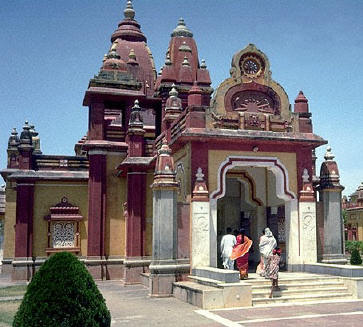-:
Hindu Temples :-
Lord Krishna Temples
Mathura Temple , Mathura

The city of Mathura, in Uttar Pradesh, the nucleus of Brajbhoomi, is located at a distance of 145 km south-east of Delhi and 58 km north-west of Agra. Covering an area of about 3,800 sq. km., today, Brajbhoomi can be divided into two distinct units - the eastern part in the trans-Yamuna tract with places like Gokul, Mahavan, Baldeo, Mat and Bajna and the western side of the Yamuna covering the Mathura region that encompasses Vrindavan, Govardhan, Kusum Sarovar, Barsana and Nandgaon.
The land of Braj starts from Kotban near Hodel
about 95 km from Delhi and ends at Runakuta which is known specially for its
association with the poet Surdas, an ardent Krishna devotee. A long line of
picturesque ghats - with their steps leading to the water's edge, arched
gateways and temple spires extending along the right bank of the River
Yamuna, emphasise the sacred character of the town of Mathura. The birth
place of Lord Krishna, "the best known, best loved and most complex of Lord
Vishnu's manifestations" - Mathura is today an important place of
pilgrimage.
Location
The city of Mathura is located in the western part of the state of Uttar
Pradesh, in the northern region of India. It is a part of the great northern
plains and is situated on the west bank of the river Yamuna. Mathura is 141
km south of Delhi and 47 km northwest of Agra. The climate of Mathura is
extreme and tropical. Summers are extremely hot and winters are cold and
foggy. It experiences southwestern monsoon rains from July to September.
History
An ancient city whose origins fade into the mists of history, Mathura's
strategic location at the cross roads of various trade routes - that went
westwards to West Asia and the Roman Empire; northwards, via Taxila,
Pushkalavati and Purushapur to Central Asia and the Silk Route and eastwards
to China - ensured its position as a centre of trade and a meeting point for
varied cultures.
By the fifth century BC, during the time of Buddha, it was a major
metropolis and the capital of the Surasena Kingdom - one of the 16
Mahajanapadas of the period. Mathura saw its `golden age' during the rule of
the Kushanas and the able governance of rulers like Kanishka, Huvishka, and
Vasishka, when the arts flourished and economic wealth grew. It remained a
centre of power during the Mauryan period, through the enlightened rule of
Emperor Ashoka (3rd century BC) to the Gupta era (4th century AD).
Brij Culture in Mathura
According to the Bhagwat Purana, Shri Krishna along with the gopis had
danced the Raas on the banks of the Yamuna at Vrindavan. When the gopis felt
conceited about Lord Krishna dancing with them, he disappeared from their
midst. In the agony of separation from their beloved Krishna, the gopis
recalled and enacted his lilas (divine episodes of his life) which in course
of time came to be known as the Raaslilas. The Raaslila in its present form
is ascribed to Swami Haridas and Shri Narayan Bhatt. Only young Brahmin boys
of 13 to 14 years of age can perform the Raaslila. The charming childhood
pranks of Shri Krishna constitute the main them of these dramas.